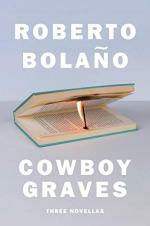|
This section contains 553 words (approx. 2 pages at 400 words per page) |

|
Cowboy Graves: Three Novellas Summary & Study Guide Description
Cowboy Graves: Three Novellas Summary & Study Guide includes comprehensive information and analysis to help you understand the book. This study guide contains the following sections:
This detailed literature summary also contains Quotes and a Free Quiz on Cowboy Graves: Three Novellas by Roberto Bolaño.
The following version of the book was used to create this guide: Bolaño, Roberto. Cowboy Graves. Penguin Books, 2022.
While Cowboy Graves is written in both the past and present tense, the guide predominantly relies on the present tense for the purpose of clarity. Roberto Bolaño’s novel Cowboy Graves is comprised of three separate novellas, “Cowboy Graves”, “French Comedy of Horrors”, and “Fatherland”, which follow the experiences of the first person narrators, Arturo Belano, Diodorus Pilon, and Rigoberto Belano respectively. In “Cowboy Graves”, Arturo Belano struggles to reconcile his Mexican and Chilean heritage; he vacillates between considering himself Mexican and Chilean. Before he, his mother, and sister move to Mexico City, to reunite with his father, Arturo attempts to say goodbye to the poet Nicanor Parra. He takes multiple buses and travels by foot to a remote town but discovers that a guitar maker occupies the house, that he thought belonged to Parra. In Mexico, Arturo skips class to go to the bookstore and cinema. He begins talking the Grub, a man who sits on a bench in the Alameda, and they discuss a famous actress and the Villaviciosa. Shortly after the Grub recovers from his illness, he moves north. Arturo attempts to get a job and start a life in Mexico but decides to return to Chile to join the revolution, instead. He is assigned to guard a desolate street and forgets the code phrase he is supposed to use, to identify himself as a comrade.
In “French Comedy of Horrors”, the first person narrator, Diodorus Pilon, sits at a café during the solar eclipse and watches a couple dance. That evening, as he walks home, he hears a payphone ring and answers the call. The anonymous voice, on the other end of the line, tells him that he is a member of the Clandestine Surrealist Group. He recounts the story of André Breton, who recruited five young surrealist artists to live in the sewer system of Paris for ten years. When he is walks home, Rigoberto sees a couple from the café, who looked directly at the eclipse and went blind.
In the last novella, “Fatherland, the first person narrator, Rigoberto Belano describes his father, who was a champion boxer. Later, he gives a disastrous poetry recitation during a rebel gathering. As he orates, two men run into the room and announce that the military coup is underway. Amid the frenzy, Rigoberto is knocked off his chair and rendered unconscious. He wakes up in the lap of Patricia Arancibia who ushers him into her Volkswagen and drives him to her home. He falls in love with Patricia before her untimely death. As “Fatherland” progresses, Rigoberto’s first person narrative passages are replaced with letters and lectures written from the first person point of view of other characters. Patricia’s father writes to Rigoberto and tells him to desist with his requests for his late daughter’s manuscripts. Juan Cherniakovski delivers a lecture on Indian culture. Bibiano Macaduck orates on the life of Juan Cherniakovski, before and after he adopts the alias Víctor Díaz. “Fatherland” concludes with a letter from Lola Fontfreda to Rigoberto Belano detailing her dream in which Fernando came to visit her and apologize for loving his art more than her.
Read more from the Study Guide
|
This section contains 553 words (approx. 2 pages at 400 words per page) |

|



